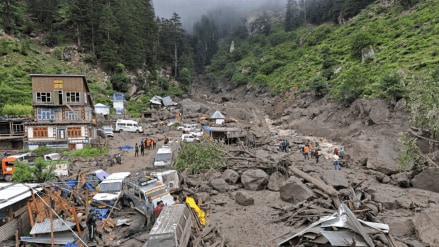Monsoon arrived in India in June, and since then, people in Jammu and Kashmir, Himachal Pradesh, Uttarakhand and Maharashtra have been reeling with back-to-back cloudbursts, landslides, and flash floods. These disasters have claimed numerous lives, left many injured and missing, and rescue and relief operations in affected areas are underway.
As the monsoon arrived at least a week early in the country, it also brought with it the mayhem. To understand the reasons behind these recurring disasters, we reached out to climate experts and an activist.
Experts warn that India is now facing the “cataclysmic consequences” of climate change, with even worse to come. The activist we spoke to sounded a similar alarm, stressing that extreme events once considered “rare”, like heavy rainfall and melting of glaciers, are now occurring with alarming frequency.
So, what’s driving cloudbursts in India?
Vishal Singh, who is an Interdisciplinary Environmental Scientist, told the FinancialExpress.com that cloudbursts in the Himalayas occur due to a combination of climate conditions and the region’s unique topography.
“Rising incidences of cloudbursts can be linked to climate change as it has amplified atmospheric variability and higher moisture levels in the air, making intense rainfall events more frequent,” he added.
Singh further pointed to deforestation and unplanned development as major contributors to “destruction” in the Himalayas. “Deforestation increases overland flows of water, causing severe soil erosion, mass wasting, landslides and flash floods downstream. Similarly, unplanned construction reduces natural infiltration, disrupts the hydrological cycle, and thus creates greater vulnerability to abrupt life-threatening weather events. Especially in geologically fragile regions such as the Himalaya.”
Singh predicted, “As climate change continues, researchers across the globe forecast higher intensity weather events, prolonged periods of drought as well as intense rainfall, in some areas such as the Himalaya, these events will not only be a new normal but also frequently catastrophic.”
Climate and sustainability expert, Shubham Thakur, told the FinancialExpress.com that the primary reason behind it is global warming. “The first and foremost reason for the escalating incidents of cloudbursts is global warming due to climate change caused by excessive human interventions. Glaciers are melting fast, monsoon patterns are changing, besides being a mountainous region that makes cloudbursts incessant and scary,” Thakur said.
Thakur added that deforestation, unchecked human activity, and shrinking glaciers are intensifying the problem. These factors not only charge clouds with excess moisture but also trap them in the terraneous region.
He warned of more such disasters in India in the coming days. “In simple terms, atmospheric moisture is increasing due to climate change. And this makes it difficult due to the topography of the mountains, too.”
He also noted that lightning, thunderstorms, rainfall and cloudbursts have now become “stronger than ever”.
Licypriya Kangujam, who is a 13-year-old climate activist, told the FinancialExpress.com, “Extreme rainfall events, once considered rare, are now becoming frequent due to rising global temperatures, melting glaciers, and changing weather patterns in the fragile Himalayan region,” before adding, “These disasters are not natural anymore but human-made, driven by our reckless exploitation of nature.”
With disasters intensifying every year, experts stress that India cannot afford complacency. The focus, they argue, must now shift to mitigation and preparedness.
What can be done to mitigate cloudbursts?
Singh emphasised that the government should invest “time and money” to bring about a social and behavioural change. “The government needs to invest in invest in advanced meteorological infrastructure at local levels in high-risk prone areas, early warning alerts and better-quality forecasting models and efficient evacuation plans.”
He, however, pointed out that the most pressing issue at hand is unregulated construction activities in high-risk and vulnerable areas, adding that such activities should be strictly discouraged and penalised to prevent further ecological damage.
Thakur said, “We need hyper-local disaster mitigation methods, climate change adaptation strategies, and better prediction of changes in weather patterns and atmospheric changes.”
“Climate adaptation is the immediate way forward until we can develop climate-resilient infrastructure and be able to predict the cloudbursts,” he added.
Thakur also highlighted the economic impact of such disasters, noting that Himachal Pradesh alone suffered losses of nearly Rs 700 crore in the 2025 monsoon.
While experts highlighted several strategies to mitigate the impact of cloudbursts, from improving forecasting systems to restricting construction in vulnerable areas, the larger question remains: how should India prepare for a future where such extreme events are only expected to intensify?
What is the way forward?
He believed that we are on a war footing and must act now. “The only way forward is to act now. And act on a war footing as 80% of our districts are highly climate vulnerable.”
The climate activist said, “Urgent climate action, sustainable planning, and preparedness are the need of the hour to protect lives and livelihoods.”
These warnings are not merely opinions; research findings back them.
Research supports these warnings. A 2017 paper titled “Cloudbursts in Indian Himalayas: A review” found that most cloudburst events occur between 1000 m to 2500 m in elevation, within the valley folds of the southern rim of the Indian Himalayas.
Similarly, a study on the Kedarnath floods concluded that more than half of the rainfall could be attributed to rising greenhouse gas concentrations and aerosol particles in the atmosphere.
Most recently, a 2025 study published in Springer Nature – “A review of cloudburst events in the Himalaya region, and 2D hydrodynamic simulation using MIKE models” – revealed an increasing rise in the frequency of cloudbursts between 1970 and 2024. Uttarakhand was identified as the worst-affected state, followed by Himachal Pradesh, with Jammu and Kashmir also showing a sharp upward trend.
